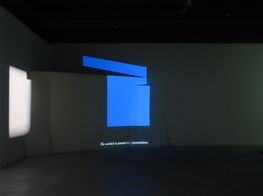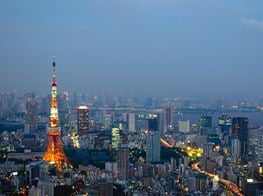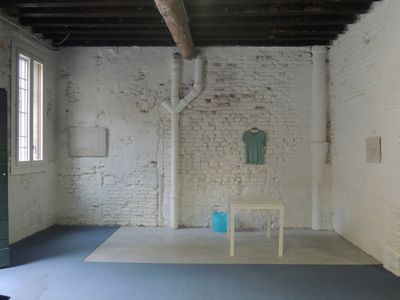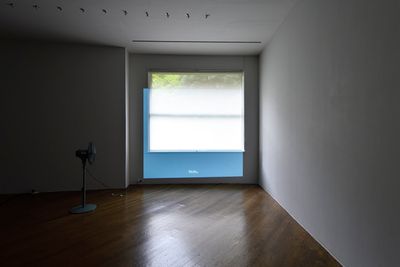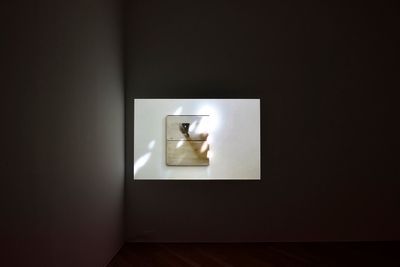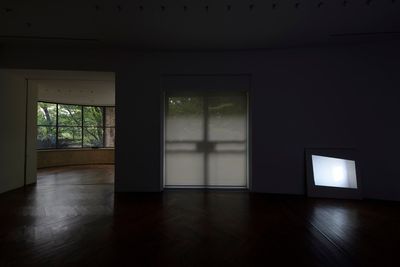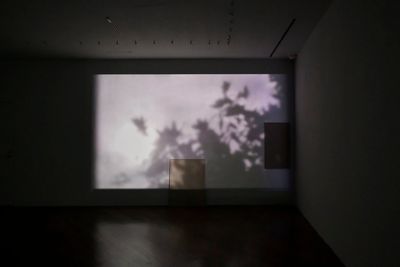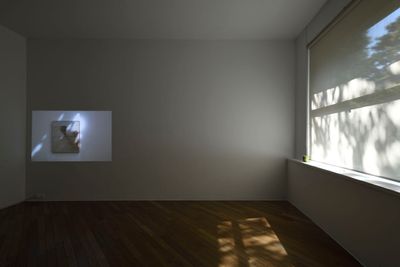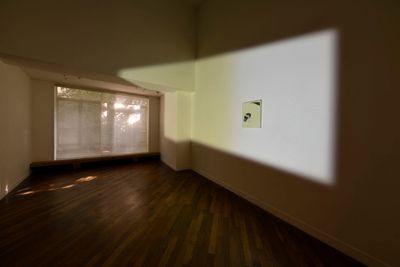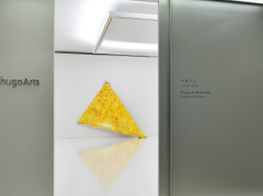Lee Kit: 'We used to be more sensitive'
Lee Kit. Courtesy © the artist and ShugoArts. Photo: Shigeo Muto.
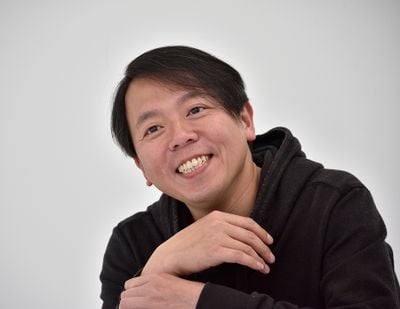
Lee Kit. Courtesy © the artist and ShugoArts. Photo: Shigeo Muto.
Lee Kit creates meditative installations—or 'situations', as the artist frequently calls them—by bringing together intangible elements, such as light and sound, with painting, moving image, and readymade objects. These situations often comprise paintings upon which light is cast from a projector, creating a visual experience more dynamic than that generated by video or painting alone.
A series of such installations were included in the artist's first institutional solo exhibition in Europe at S.M.A.K., Ghent: A small sound in your head (28 May–4 September 2016), which ran concurrently to Hold your breath, dance slowly at Walker Art Center in Minneapolis (12 May–9 October 2016). At Walker Art Center, the installation Hey (the lasting care) (2016) consisted of a looped video of closely cropped, pale, grey-blue hands and feet projected onto a wall, onto which a piece of plywood painted in glossy, transparent paint was also hung. To the right of the projection lay a carpet, its left side falling beneath the bottom-right side of the projection; beside this, a small paper painting depicted a smaller close-up of hands touching feet with the word 'Hey' inscribed beneath.
Lee's installations often feature short text excerpts, many harbouring pop cultural references. The title of his show at TheCube Project Space in Taipei (18 February–9 April 2017)—'The more I ignore you, the closer you get.'—refers to Morrissey's 1994 single, 'The More You Ignore Me, the Closer I Get'. A low-res photograph of a Hong Kong seascape overlaid with the exhibition's title illustrated the show's press release, transforming a simple scene into an image with expanded narrative possibilities.
The muted tones that tie Lee's pieces together—often blue, grey, and white—hint at the artist's background in painting, developed during his BFA and MFA at The Chinese University of Hong Kong. He started his 'Hand-painted cloth' series (2001–ongoing) during his time as a student.
An early example features in the 2003 photograph Sunday Afternoon: Picnic with friends and hand-painted cloth at Yung Shu O, Sai Kung, in which a hand-painted red, blue and white-striped fabric—a ubiquitous pattern in many parts of Asia—is used as a picnic blanket. The artist has described the use of his cloth paintings for daily activities as a by-product of the process of making work. His 2016 S.M.A.K. solo exhibition included hand-painted cloth used to clean window (2008): a small photograph capturing the cleaning of a window with a patterned cloth, and the slightly crumpled and dirtied cloth in question pinned to the wall.
Presented in the Hong Kong pavilion at the 55th Venice Biennale, Lee's installation You (you) showcased the artist's approach to his installations as expanded compositions. The pavilion's floor was covered in a blue office carpet, while a selection of domestic objects—such as an unplugged hairdryer on the carpet, or a vacuum cleaner with its pipe leaning against the wall—were situated around the white-walled room.
Between 16 September and 24 December 2018, the Hara Museum of Contemporary Art in Tokyo presented Lee Kit 'We used to be more sensitive.'—a series of installations intended to radiate a sense that 'time has stopped.' Lee discusses the exhibition and his practice in this conversation, which was transcribed from a talk staged between the artist and Hara Museum of Contemporary Art curator, Atsuo Yasuda, on the exhibition's opening day.
AYAfter your first visit to Hara Museum, we discussed how you were inspired by the location. At some point you requested to construct walls within the space. Where did the idea to divide the space and add artificial elements come from?
LKI really like the Hara Museum; I think it's my favourite museum, at least in Tokyo. When I made the site visit, the first thing I noticed was the windows and the natural light. The whole space is like a canvas; I had to start with something and that's why I divided the space. I also divided it based on the parts that I don't like—I wanted to hide certain corners—and added a screen in front of the windows at the back. I did this to soften everything and create a certain feeling, as if time had stopped.
AYHow did the process and pace of reading and comprehending the space develop over time?
LKI first adjusted myself to working in Tokyo. Each day, I arrived at the museum at about half past eleven and spent six to seven hours working. After, I would go to the supermarket to buy dinner, then go back to my hotel room to eat and watch Netflix. After that, I would start writing and editing videos again. I need a certain rhythm when I work. I try not to tell myself that I'm doing an exhibition, because I hate the industry. Why do we do exhibitions? This is a question that I ask myself. Yasuda-san witnessed that. He usually spends his time in the office, but sometimes he would come to the gallery and I would just be walking around.
Creating exhibitions is like acting; I have to keep a certain distance. When I walk around the space I enable myself to get closer to what I want to achieve. It also allows me to filter my thoughts.
AYYou're no stranger to Tokyo—you've already exhibited here several times, but this was your first institutional solo exhibition in the city. The location is also different; it's more residential, being the former home of the Hara family, and a rare example of early modern residential architecture. How did the physicality of the space affect your art-making?
LKFirst, it had to do with the lighting. It's also related to what I just said about walking around the museum. It all starts to appear once I place myself in the environment. I often use a very simple approach. I never use HD video, simply because I don't have time to waste on rendering. My approach also matches the lighting in the museum—it's very soft. When the projections come in contact with the screens, they create a texture that I cannot achieve through painting or HD video alone.
The other aspect is the feeling of loneliness that exists in this museum. I always relate loneliness to Tokyo; it has a certain type of loneliness that is neither positive nor negative. The museum also has that; it's a very civilised kind of loneliness. I just wanted to capture that as something human.
What also inspires me about the space is the acoustics, because the ceiling is relatively low. I was thinking about putting some sound elements in the show, but when I walked around I realised there was an echo. I wanted to create sound by not including any sound. Sound is also related to the concept of distance that I was talking about.
AYThe sound of the projectors' fans was audible throughout the exhibition. You also placed a fan upstairs, adding to that sound. So, in a sense you did incorporate sound.
LKI cannot cancel out sound. When I'm sitting at home alone, with a fan on—that sound reminds me that I'm alone.
AYApart from the light coming from your projections, a lot of the lights in the museum were turned off. The dependence on natural light meant that the show constantly changed depending on the weather and time of day. It was a one-off experience at every moment.
LKI use light from the projections because I hate spotlights. It goes back to when I was young at school, and had to present work beneath a spotlight. I really liked the fact that no one could see the whole show, including me. It changed constantly, but not in a very drastic way. I think that if my own art practice is related to life, it must remain natural. It's also a way for me to avoid total control.
AYThe projections are occasionally paired with paintings, or what resemble paintings. In that respect, your work questions what painting is. In the past you have painted on tablecloths and curtains, making use of daily objects, which raises a fundamental question about the medium. This question is also raised in the exhibition.
LKI constantly think about what a painting is. Of course, I still don't know what the answer is, but I think painting is more about the practice rather than form. People constantly debate about whether the medium is dead or alive. I think what's more important is the topic of the painter's attitude and gaze, because now we look at our phones more than anything. We are having to re-learn how to gaze at something.
AYText is another interesting component of your work. The projections and paintings contain short, ambiguous excerpts of text that lead us to consider many things.
LKOver the past two or three years, text has become the weight of my works. The exhibition is formally beautiful without text, but it requires some weight. Text gives my works a kind of punch.
I spend more time travelling than usual because of exhibitions; writing and creating stories has become a very good way for me to produce work and to get closer to myself. Some artists make very long videos and claim that if you don't watch the whole thing then it can't be understood. I don't want to prove myself as an artist by distancing people.
I also think that everything is just a trigger. When I see an artwork that triggers me in some way, it does so because it provides an experience. With text, the meaning suddenly changes that experience. The text is just the voice in our heads. I think we all talk to ourselves, whether we're in the shower, bus, or in the street. I'm just trying to capture that trigger.
AYThe text excerpts are always in English. It was a bit of a stretch to come up with the Japanese translation for the title, 'We used to be more sensitive.', in order to convey the ambiguity that it expresses in English.
LKIt goes back to the voice in our heads, and the idea that we cannot truly express what is being said in our heads. For example, if I were looking at the audience and thinking 'I love you', and then said it out loud, they'd be wondering why I was saying that; even if I was being very sincere. By capturing it in my work, it becomes something that sits in between; that has a double or even triple meaning.
AYHow did you come up with the title?
LKA few months ago I was in Tuscany—I did another solo show in a small town called San Giovanni Valdarno. It took me a while to learn how to pronounce the name of the town. It's a very small town, with a population of around 17,000. I seemed to be the only Asian there. They kept calling me Chinese, even though I explained that I'm from Hong Kong. At the beginning it made me very annoyed, but then I realised that this is just how they live, and suddenly this sentence appeared in my mind: 'We used to be more sensitive'.
I'm a city person—it's a luxury for me to stay in a small town, but I'm unable to get used to it. It's easy to misunderstand what I just said about sensitivity. I don't mean that we are not sensitive; I mean that we are now truly sensitive. For example, if I told an American that I don't like Donald Trump, and they interpreted that as me not liking the United States—that is too sensitive. To bring this title into the political realm might be going too far, but this is the reality of the world we live in.—[O]

